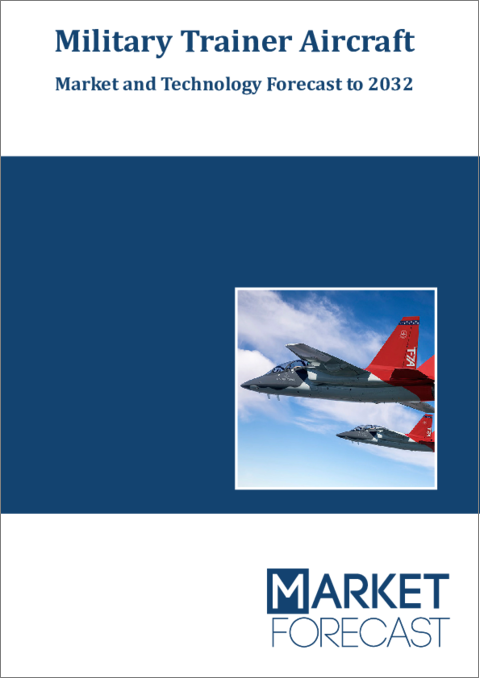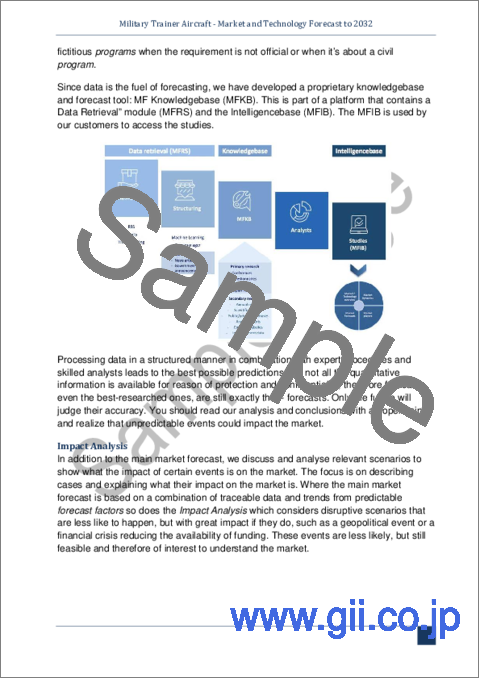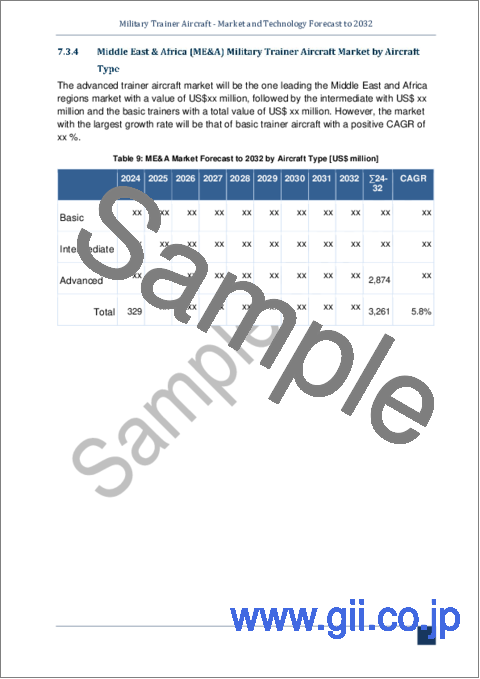|
|
市場調査レポート
商品コード
1420450
軍用練習機:市場および技術予測 (~2032年)Military Trainer Aircraft - Market and Technology Forecast to 2032 |
||||||
|
|||||||
| 軍用練習機:市場および技術予測 (~2032年) |
|
出版日: 2024年01月15日
発行: Market Forecast
ページ情報: 英文 140 Pages
納期: 即日から翌営業日
|
全表示
- 概要
- 目次
世界の軍用練習機の市場規模は、予測期間中は3.5%のCAGRで推移し、2032年には180億1,000万米ドルの規模に成長すると予測されています。
米国空軍の新型高性能練習機の導入と、他の2部門における保有機のアップグレードにより、北米市場が最大のシェアを占める見通しです。
大国間の競合が再び前面に出てきており、国際システムは大きな課題を提示しています。一方、世界のいくつかの地域では低強度の紛争も発生しています。このような枠組みのもとで、航空戦力は、戦力増強や、より長距離・短時間で戦力を発揮する手段を提供します。これらが軍用練習機市場を牽引する要素です。
当レポートでは、世界の軍用練習機の市場を調査し、市場および技術の概要、市場成長への各種影響因子および市場機会の分析、市場規模の推移・予測、各種区分・地域別の詳細分析、主要企業のプロファイルなどをまとめています。
目次
第1章 イントロダクション
第2章 エグゼクティブサマリー
第3章 技術と開発
- 技術概要
- 練習機の種類
- 初級および中級練習機
- 先進練習機
第4章 市場概要
- 市場力学
- 練習機の数量分布予測:地域別
第5章 市場分析・予測要素
- 市場の分類
- 促進要因
- 動向
- 機会
- 課題
第6章 国別分析
- 米国
- 韓国
- インド
- 欧州諸国
第7章 世界および地域市場の予測
- 地域別市場:概要
- 北米:航空機タイプ別
- 欧州:
- アジア太平洋:航空機タイプ別
- 中東・アフリカ:航空機タイプ別
- ラテンアメリカ:航空機タイプ別
- 地域別市場:推進区分別
- 北米
- 欧州
- アジア太平洋
- 中東・アフリカ
- ラテンアメリカ
- 機会分析
第8章 市場予測:航空機タイプ別
- 市場概要
- タイプ別市場:地域別
- 基礎練習機
- 中級練習機
- 先進練習機
- タイプ別市場:推進区分別
- 基礎練習機
- 中級練習機
- 先進練習機
- 機会分析
第9章 市場予測:推進区分別
- 市場予測
- 市場概要
- 推進装置市場:地域別
- プロペラ練習機
- ジェット練習機
- 推進装置市場:航空機タイプ別
- プロペラ練習機
- ジェット練習機
- 機会分析
第10章 影響分析
- 予測要因と市場への影響
第11章 主要企業
- Pilatus Aircraft
- Boeing
- Diamond Aircraft Industries
- Hindustan Aeronautics Limited (HAL)
- BAE Systems
- Textron Aviation
- Embraer
- Leonardo S.p.A
- Turkish Aerospace Industries
- Korea Aerospace Industries (KAI)
- Aero Vodochody
- Northrop Grumman
- Cirrus Aircraft
第12章 結果・総論
第13章 市場予測について
付録A:記載企業
付録B:略語
付録C:練習機市場のサプライチェーン
The global military trainer aircraft market is projected to grow up to US$18.01 billion throughout the 2024-2032 period, with a CAGR of 3.5%. The North American market will account for the largest share thanks to the US Air Force's induction of new advanced trainers and the upgrades of the fleets in the two other segments.
The international system presents major challenges with competition among great powers being back at the forefront. However, low-intensity conflicts are present in several regions of the world. Under this framework, air power provides the force multiplier and the tools to project power at longer distances and in short time, among other advantages. These are elements that drive the market for military trainer aircraft.
Maintaining the necessary capabilities comes at a very high financial cost and so does quality training. The global economic situation can make it even more difficult to sustain the aircraft and cover the rising energy costs. There can be several approaches to these problems that can include the adjustment of the training schedule and the flight hours, the use of a single type of aircraft for the first two stages or using older variants of the aircraft in service, increasing the hours in flight simulators, which can be interconnected to simulate group operations, and finally acquiring training as a service.
While the latter is a different market in itself, it drives the market for trainer aircraft and for older fighter aircraft which can be used in "aggressor" roles.
Covered in this study:
- Overview: Snapshot of the Trainer Aircraft technology in the military market during 2024-2032, including highlights of the demand drivers, trends, and challenges. It also provides a snapshot of the spending with respect to regions as well as segments and sheds light on the emergence of new technologies.
- Market Dynamics: Insights into the technological developments in the Military Trainer Aircraft market and a detailed analysis of the changing preferences of governments around the world. It also analyses changing industry structure trends and the challenges faced by the industry participants.
- Segment Analysis: Insights into the various systems market from a segmental perspective and a detailed analysis of factors influencing the market for each segment.
- Regional Review: Insights into modernisation patterns and budgetary allocation for top countries within a region.
- Regional Analysis: Insights into the systems market from a regional perspective and a detailed analysis of factors influencing the market for each region.
- Impact Analysis: Analysis on how certain events will impact the Military Trainer Aircraft market. This will give you an indication on which factors are important for the forecast.
- Key Program Analysis: Details of the top programs in each segment expected to be executed during the forecast period.
- Competitive landscape Analysis: Analysis of competitive landscape of this industry. It provides an overview of key companies, together with insights such as key alliances, strategic initiatives, and a SWOT analysis.
We have segmented the Military Trainer Aircraft market in three major groups. We've researched these major segments and provide forecast figures for 2024 - 2032. The segments are:
Region
- North America
- Asia Pacific (APAC)
- Europe
- Middle East & Africa (ME&A)
- Latin America (LATAM)
Propulsion
- Propeller
- Jet
Type
- Basic Trainer
- Advanced Trainer
- Intermediate Trainer
Reasons to buy:
- Insight on the military trainer aircraft technologies and designs.
- Understanding of the market in terms of demand drivers, industry trends, and the latest technological developments, which shape the market.
- In-depth understanding of other factors affecting the market such as defence spending, operational requirements and challenges faced by manufacturers, among several others.
- Presenting the disruptions and the technology enablers impacting the market and how these could become an opportunity in this domain.
- Identify opportunities available in the market.
Companies Listed:
|
|
Table of Contents
1. Introduction
- 1.1. Scope
- 1.2. Methodology
- 1.3. Who will benefit from this study?
2. Executive Summary
- 2.1. Trends and Insights
- 2.2. Main Findings
- 2.3. Key Conclusions
3. Technologies and Developments
- 3.1. Technology overview
- 3.2. Types of Trainer Aircraft
- 3.2.1. Basic and Intermediate Trainer Aircraft
- 3.2.2. Advanced Trainer Aircraft
4. Market Overview
- 4.1. Introduction
- 4.1.1. Classification
- 4.1.2. Exclusion
- 4.2. Market dynamics
- 4.3. Trainer Aircraft market volumes distribution over forecast period by Region
5. Market Analysis and Forecast Factors
- 5.1. Market Segmentation
- 5.2. Drivers
- 5.3. Trends
- 5.4. Opportunities
- 5.5. Challenges
6. Country Analysis
- 6.1. United States
- 6.2. South Korea
- 6.3. India
- 6.4. European countries
7. Global and Regional Market Forecast to 2032
- 7.1. Introduction
- 7.2. Military Trainer Aircraft market by Region Overview
- 7.3. Military Trainer Aircraft market Regions by Aircraft Type
- 7.3.1. North American Military Trainer Aircraft Market by Aircraft Type
- 7.3.2. European Military Trainer Aircraft Market by Aircraft Type
- 7.3.3. Asia-Pacific (APAC) Military Trainer Aircraft Market by Aircraft Type
- 7.3.4. Middle East & Africa (ME&A) Military Trainer Aircraft Market by Aircraft Type
- 7.3.5. Latin America (LATAM) Military Trainer Aircraft Market by Aircraft Type
- 7.4. Trainer Aircraft Market Regions by Propulsion
- 7.4.1. North American Military Trainer Aircraft Market by Propulsion
- 7.4.2. European Military Trainer Aircraft Market by Propulsion
- 7.4.3. Asia-Pacific (APAC) Military Trainer Aircraft Market by Propulsion
- 7.4.4. Middle East & Africa (ME&A) Military Trainer Aircraft Market by Propulsion
- 7.4.5. Latin America (LATAM) Military Trainer Aircraft Market by Propulsion
- 7.5. Opportunity Analysis
8. Market Forecast to 2032 by Aircraft Type
- 8.1. Introduction
- 8.2. Military Trainer Aircraft Market by Aircraft Type Overview
- 8.3. Military Trainer Aircraft Types market by Region
- 8.3.1. Basic Trainer Aircraft market by Region
- 8.3.2. Intermediate Trainer Aircraft Market by Region
- 8.3.3. Advanced Trainer Aircraft market by Region
- 8.4. Trainer Aircraft Types market by Propulsion
- 8.4.1. Basic Trainer Aircraft market by Propulsion
- 8.4.2. Intermediate Trainer Aircraft market by Propulsion
- 8.4.3. Advanced Trainer Aircraft market by Propulsion
- 8.5. Opportunity Analysis
9. Market Forecast to 2032 by Propulsion
- 9.1. Market Forecast to 2032 by Propulsion
- 9.2. Introduction
- 9.3. Military Trainer Aircraft market by Propulsion Overview
- 9.4. Military Trainer Aircraft Propulsions market by Region
- 9.4.1. Propeller Trainer Aircraft market by Region
- 9.4.2. Jet Trainer Aircraft market by Region
- 9.5. Military Trainer Aircraft Propulsions market by Aircraft Type
- 9.5.1. Propeller Trainer Aircraft market by Aircraft Type
- 9.5.2. Jet Trainer Aircraft market by Aircraft Type
- 9.6. Opportunity Analysis
10. Impact Analysis
- 10.1. Introduction
- 10.2. Forecast factors and Market Impact
11. Leading Companies
- 11.1. Pilatus Aircraft
- 11.1.1. Introduction
- 11.1.2. Trainer Aircraft-Products and Services
- 11.1.3. Recent Developments and Contracts
- 11.1.4. SWOT Analysis
- 11.2. Boeing
- 11.2.1. Introduction
- 11.2.2. Trainer Aircraft-Products and Services
- 11.2.3. Recent Developments and Contracts
- 11.2.4. SWOT Analysis
- 11.3. Diamond Aircraft Industries
- 11.3.1. Introduction
- 11.3.2. Trainer Aircraft-Products and Services
- 11.3.3. Recent Developments and Contracts
- 11.3.4. SWOT Analysis
- 11.4. Hindustan Aeronautics Limited (HAL)
- 11.4.1. Introduction
- 11.4.2. Trainer Aircraft-Products and Services
- 11.4.3. Recent Developments and Contracts
- 11.4.4. SWOT Analysis
- 11.5. BAE Systems
- 11.5.1. Introduction
- 11.5.2. Trainer Aircraft-Products and Services
- 11.5.3. Recent Developments and Contracts
- 11.5.4. SWOT Analysis
- 11.6. Textron Aviation
- 11.6.1. Introduction
- 11.6.2. Trainer Aircraft-Products and Services
- 11.6.3. Recent Developments and Contracts
- 11.6.4. SWOT Analysis
- 11.7. Embraer
- 11.7.1. Introduction
- 11.7.2. Trainer Aircraft-Products and Services
- 11.7.3. Recent Developments and Contracts
- 11.7.4. SWOT Analysis
- 11.8. Leonardo S.p.A
- 11.8.1. Introduction
- 11.8.2. Trainer Aircraft-Products and Services
- 11.8.3. Recent Developments and Contracts
- 11.8.4. SWOT Analysis
- 11.9. Turkish Aerospace Industries
- 11.9.1. Introduction
- 11.9.2. Trainer Aircraft-Products and Services
- 11.9.3. Recent Developments and Contracts
- 11.9.4. SWOT Analysis
- 11.10. Korea Aerospace Industries (KAI)
- 11.10.1. Introduction
- 11.10.2. Trainer Aircraft-Products and Services
- 11.10.3. Recent Developments and Contracts
- 11.10.4. SWOT Analysis
- 11.11. Aero Vodochody
- 11.12. Northrop Grumman
- 11.13. Cirrus Aircraft
12. Results and Conclusions
13. About Market Forecast
- 13.1. General
- 13.2. Contact us
- 13.3. Disclaimer
- 13.4. License
Appendix A: Companies Mentioned
Appendix B: Abbreviations
Appendix C: The trainer aircraft market supply chain
List of figures
- Figure 1: Trainer Aircraft Market Summary by Region
- Figure 2: Trainer Aircraft Market Summary by Aircraft Type
- Figure 3: Trainer Aircraft Market Summary by Propulsion [US$ million]
- Figure 4: Tecnam P-2002 Basic Trainer Aircraft
- Figure 5: T-6 Texan II Intermediate Trainer Aircraft
- Figure 6: Garmin G1000 NXi Avionics
- Figure 7: McCauley's Blackmac series four-blade aluminum propeller
- Figure 8: Pratt & Whitney PT6A-68 Turboprop Engine
- Figure 9: Boeing T-7 Red Hawk Advanced Jet Trainer
- Figure 10: M-345 Advanced Jet Trainer Avionics
- Figure 11: F135 Advanced Engine
- Figure 12: Douglas A-4 Skyhawk Advanced Trainer
- Figure 13: Market Structure
- Figure 14: Market Segmentation and Sub-segmentation Trainer Aircraft Market
- Figure 15: Military Trainer Aircraft's Regional Market Share [%]
- Figure 16: N. American Market Forecast to 2032 by Aircraft Type [US$ million]
- Figure 17: N. American Market Forecast to 2032 by Type of Aircraft [%]
- Figure 18: European Market Forecast to 2032 by Aircraft Type [US$ million]
- Figure 19: European Market Forecast to 2032 by Aircraft Type [%]
- Figure 20: APAC Market Forecast to 2032 by Aircraft Type [US$ million]
- Figure 21: APAC Market Forecast to 2032 by Aircraft Type [%]
- Figure 22: ME&A Market Forecast to 2032 by Aircraft Type [US$ million]
- Figure 23: ME&A Market Forecast to 2032 by Aircraft Type [%]
- Figure 24: LATAM Market Forecast to 2032 by Aircraft Type [US$ million]
- Figure 25: LATAM Market Forecast to 2032 by Aircraft Type [%]
- Figure 26: N. America Market Forecast to 2032 by Propulsion [US$ million]
- Figure 27: N. America Market Forecast to 2032 by Propulsion [%]
- Figure 28: European Market Forecast to 2032 by Propulsion [US$ million]
- Figure 29: European Market Forecast to 2032 by Propulsion [%]
- Figure 30: APAC Market Forecast to 2032 by Propulsion [US$ million]
- Figure 31: APAC Market Forecast to 2032 by Propulsion [%]
- Figure 32: ME&A Market Forecast to 2032 by Propulsion [US$ million]
- Figure 33: ME&A Market Forecast to 2032 by Propulsion [%]
- Figure 34: LATAM Market Forecast to 2032 by Propulsion [US$ million]
- Figure 35: LATAM Market Forecast to 2032 by Propulsion [%]
- Figure 36: Trainer Aircraft market seize, 2024-2032 (US$ billion) by Region
- Figure 37: Trainer Aircraft market CAGR, 2024-2032 by Region
- Figure 38: Basic Trainer Aircraft Market Forecast to 2032 by Region [US$ million]
- Figure 39: Basic Trainer Aircraft Market Forecast to 2032 by Region [%]
- Figure 40: Intermediate Trainer Aircraft Market Forecast to 2032 by Region [US$ million]
- Figure 41: Intermediate Trainer Aircraft Market Forecast to 2032 by Region [%]
- Figure 42: Advanced Trainer Aircraft Market Forecast to 2032 by Region [US$ million]
- Figure 43: Advanced Trainer Aircraft Market Forecast to 2032 by Region [%]
- Figure 44: Basic Trainer Aircraft Market Forecast to 2032 by Region [US$ million]
- Figure 45: Basic Trainer Aircraft Market Forecast to 2032 by Propulsion [%]
- Figure 46: Intermediate Trainer Aircraft Market Forecast to 2032 by Propulsion [US$ million]
- Figure 47: Intermediate Trainer Aircraft Market Forecast to 2032 by Propulsion [%]
- Figure 48: Advanced Trainer Aircraft Market Forecast to 2032 by Propulsion [US$ million]
- Figure 49: Advanced Trainer Aircraft Market Forecast to 2032 by Propulsion [%]
- Figure 50: Trainer Aircraft market seize, 2024-2032 (US$ billion) by Aircraft Type
- Figure 51: Trainer Aircraft market CAGR, 2024-2032 by Aircraft Type
- Figure 52: Propeller Trainer Aircraft Market Forecast to 2032 by Region [US$ million]
- Figure 53: Propeller Trainer Aircraft Market Forecast to 2032 by Region [%]
- Figure 54: Jet Trainer Aircraft Market Forecast to 2032 by Region [US$ million]
- Figure 55: Jet Trainer Aircraft Market Forecast to 2032 by Region [%]
- Figure 56: Propeller Trainer Aircraft Market Forecast to 2032 by Aircraft Type [US$ million]
- Figure 57: Propeller Trainer Aircraft Market Forecast to 2032 by Aircraft Type [%]
- Figure 58: Jet Trainer Aircraft Market Forecast to 2032 by Aircraft Type [US$ million]
- Figure 59: Jet Trainer Aircraft Market Forecast to 2032 by Aircraft Type [%]
- Figure 60: Trainer Aircraft market seize, 2024-2032 [US$ million] by Propulsion
- Figure 61: Trainer Aircraft market CAGR, 2024-2032 by Populsion
- Figure 62: Scenario I vs Scenario II, Global Military Trainer Aircraft Market Forecast to 2032 [US$ million]
- Figure 63: Scenario I vs Scenario II, North American Military Trainer Aircraft Market Forecast to 2032 [US$ million]
- Figure 64: Scenario I vs Scenario II, European Military Trainer Aircraft Market Forecast to 2032 [US$ million]
- Figure 65: Scenario I vs Scenario II, Asian-Pacific Military Trainer Aircraft Market Forecast to 2032 [US$ million]
- Figure 66: Scenario I vs Scenario II, Middle East & Africa Military Trainer Aircraft Market Forecast to 2032 [US$ million]
- Figure 67: Scenario I vs Scenario II, Latin American Military Trainer Aircraft Market Forecast to 2032 [US$ million]
List of tables
- Table 1: Trainer Aircraft Market Summary by Region [US$ million]
- Table 2: Trainer Aircraft Market Summary by Aircraft Types [US$ million]
- Table 3: Trainer Aircraft Market Summary by Propulsion [US$ million]
- Table 4: Market activity
- Table 5: Military Trainer Aircraft Market Forecast to 2032 by Region [US$ million]
- Table 6: N. American Military Trainer Market Forecast to 2032 by Aircraft Type [US$ million]
- Table 7: European Market Forecast to 2032 by Aircraft Type [US$ million]
- Table 8: APAC Market Forecast to 2032 by Aircraft Type [US$ million]
- Table 9: ME&A Market Forecast to 2032 by Aircraft Type [US$ million]
- Table 10: LATAM Market Forecast to 2032 by Aircraft Type [US$ million]
- Table 11: N. America Market Forecast to 2032 by Propulsion [US$ million]
- Table 12: European Market Forecast to 2032 by Propulsion [US$ million]
- Table 13: APAC Market Forecast to 2032 by Propulsion [US$ million]
- Table 14: ME&A Market Forecast to 2032 by Propulsion [US$ million]
- Table 15: LATAM Market Forecast to 2032 by Propulsion [US$ million]
- Table 16: Military Trainer Aircraft Market by Aircraft Type
- Table 17: Basic Trainer Aircraft Market Forecast to 2032 by Region [US$ million]
- Table 18: Intermediate Trainer Aircraft Market Forecast to 2032 by Region [US$ million]
- Table 19: Advanced Trainer Aircraft Market Forecast to 2032 by Region [US$ million]
- Table 20: Basic Trainer Aircraft Market Forecast to 2032 by Region [US$ million]
- Table 21: Intermediate Trainer Aircraft Market Forecast to 2032 by Propulsion [US$ million]
- Table 22: Advanced Trainer Aircraft Market Forecast to 2032 by Propulsion [US$ million]
- Table 23:Trainer Aircraft Market Forecast to 2032 by Propulsion [US$ million]
- Table 24: Propeller Trainer Aircraft Market Forecast to 2032 by Region [US$ million]
- Table 25: Jet Trainer Aircraft Market Forecast to 2032 by Region [US$ million]
- Table 26: Propeller Trainer Aircraft Market Forecast to 2032 by Aircraft Type [US$ million]
- Table 27: Jet Trainer Aircraft Market Forecast to 2032 by Aircraft Type [US$ million]
- Table 28: Scenario I vs Scenario II, Global Military Trainer Aircraft Market Forecast to 2032
- Table 29: Pilatus Aircraft Company SWOT Analysis
- Table 30: Boeing Company SWOT Analysis
- Table 31: Diamond Aircraft Industries Company SWOT Analysis
- Table 32: Hindustan Aeronautics Limited (HAL) Company SWOT Analysis
- Table 33: BAE Systems Company SWOT Analysis
- Table 34: Textron Aviation Company SWOT Analysis
- Table 35: Embraer Company SWOT Analysis
- Table 36: Leonardo S.p.A Company SWOT Analysis
- Table 37: Turkish Aerospace Industries Company SWOT Analysis
- Table 38: Korea Aerospace Industries (KAI) Company SWOT Analysis






